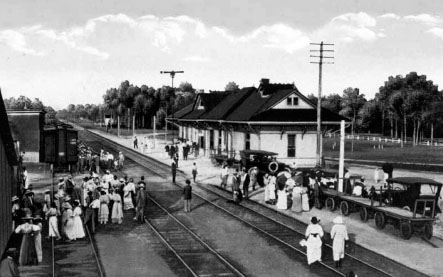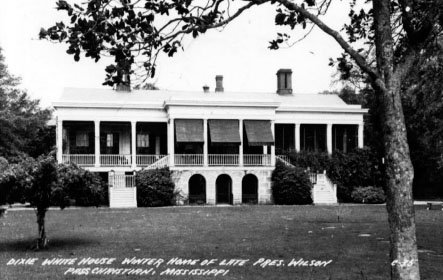Legends and Lore of the Mississippi Golden Gulf Coast (18 page)
Read Legends and Lore of the Mississippi Golden Gulf Coast Online
Authors: Edmond Boudreaux Jr.


Pass Christian's L&N Railroad Station.
Courtesy of Alan Santa Cruz Collection
.
Pass Christian started preparing for its distinguished guest. In fact, all along the Mississippi Gulf Coast, trees and bushes were trimmed. Beaches were cleared of debris, wooden fences were painted and streets were cleared. American flags were flying along the coast for the first time since the Civil War. Congressman Harrison, who was instrumental in the president's decision to visit the coast, was to accompany the president. Other individuals in the presidential party included Mrs. Wilson; their daughters, Miss Margaret and Eleanor Wilson; Miss Helen Woodrow Bones; Dr. Cary Grayson USN, the president's personal physician; and Charles Waem, the president's stenographer. There was also a Pullman car full of newspaper reporters. The first family was accompanied by three Secret Service agents and rode a special Southern Railroad train from Washington, D.C., to Pass Christian. The Wilsons spent Christmas Eve aboard a private railroad car named Ideal.
The presidential party arrived in Pass Christian early Christmas morning of 1913. They stayed in the Beaulieu Mansion, owned by Mrs. J.M. Ayers of New Jersey. The Antebellum Beaulieu was built about 1851 and was known locally as the Herndon Home because it was rented by Mrs. Thomas Herndon and her daughter, Alice. The Herndons gladly played the role of presidential hostesses. Flowers, greenery and satsuma trees full of fruit had been transplanted on the Beaulieu property. Reporters had dubbed the home the “Winter White House.” The Herndon Home would later become known as the Dixie White House. During the president's stay, the Coast Guard cutter
Winona
was moored in front of the house.
The
Daily Herald
headline of December 27 read, “Little Girl Presents Wilson with Flowers.” The president and Dr. Grayson had played a round of golf, and on their return trip, a small girl flagged the car down. The young girl was Theo Carmichael, and it was reported she was the granddaughter of Dr. and Mrs. W.T. Price. She presented the president with a bouquet of roses.
The same article also outlined the many leisure activities enjoyed by the first family during their stay. It was also reported that Misses Eleanor and Margaret Wilson had been riding horses, and that the president planned to sleep at least nine hours each night. During the day, President Wilson planned to play golf each morning at the Coast Country Club in Gulfport, and after lunch, he looked forward to a car ride, followed by long walks on the beach with Mrs. Wilson. Before retiring for the evening, he wanted to spend some time reading.
The president celebrated his fifty-seventh birthday on December 28. The first family attended church at the First Presbyterian Church in Gulfport. The small green church was located on Thirty-first Avenue, and Dr. H.A. Jones was pastor. After church services, the family returned to the Herndon Home, where the president received many telegrams from around the nation wishing him a happy birthday. Later that afternoon during his walk, he was greeted by another little girl who also presented him with a bouquet of flowers.
The president and his family continued to enjoy Mississippi's Golden Gulf Coast for the next few days. On January 2, rumors of war with Mexico surfaced when John Lind, special envoy to Mexico, arrived to confer with the president. The media indicated that Lind had secretly left Vera Cruz onboard USS
Chester
, a naval cruiser, to meet with the president about a worsening relationship with the Mexican government. The USS
Chester
had anchored near Ship Island. After the departure of John Lind and the
Chester
, the rumors died. But before the year ended, the president would send U.S. troops, under General Pershing, to Vera Cruz and later into the interior of Mexico in an attempt to capture Pancho Villa.

President Woodrow Wilson is seen playing golf at the Coast Country Club in Biloxi.
Courtesy of Alan Santa Cruz Collection
.
On New Year's Eve, the president and Mrs. Wilson attended a celebration in the Mexican Gulf Hotel in Pass Christian. This event was sponsored by the citizens of Pass Christian.
On Sunday, January 4, President Wilson and his family attended services at the First Presbyterian Church in Biloxi. The church was located at 523 East Howard Avenue, which would have placed it near the present-day Biloxi Community Center. The Reverend W.M. Megginson conducted the services. Upon conclusion of the service, Reverend Megginson requested that the congregation stand and remain so until the presidential party had left the church.
Two days later, on January 6, two hundred students from Long Beach, headed by their principal, Mr. Girault, saluted the president by waving American flags. The same day, the Gulfport Volunteer Hook and Ladder Company bestowed a membership to their company on President Wilson for an act of bravery. After a game of golf on December 28, the president's motorcade came to the aid of a Gulfport homeowner. The president noticed smoke and flames coming from the roof. The three Secret Service men took fire extinguishers from the vehicles and extinguished the fire, while the president helped quiet the confused owner. The
Daily Herald
headline of January 10 read “President Releases Dove of Peace as Twilight Marks End of Day.” The dove was the gift of a small girl named Willa Green, the daughter of Mrs. R.B. Green of Gulfport. It appears the little girl was going to present the dove near Gulfport City Hall. As the president approached, she froze, but thanks to the aid of Mrs. V.M. Noblin, the box containing the dove and a note from Willa was presented to the president. The note indicated that the dove had been cared for by Willa for several months. The bird's wing had been damaged when it flew into a door, but it was now fully recovered. Willa requested that the president do the honors of giving the bird its freedom. President Wilson took the bird to the “Winter White House,” and at twilight, the first family opened the box. The dove flew into the Pass Christian sky to its freedom.
On January 10, President and Mrs. Wilson gave a community-wide reception as a farewell gesture. The president and his family wanted to thank Gulf Coast residents for respecting his wishes for rest and quiet while he recovered his health. The reception was held at the Herndon Home at 3:00 p.m. This was Mississippi's first presidential reception, as well as President Wilson's first public reception since taking office. There was a continuous line of streetcars, carriages and cars streaming toward Pass Christian. To handle the large crowd, local law enforcement assisted the Secret Service men. Two individuals mentioned in the paper as helping with this security detail were Deputy Sheriff Alex Ewing and Officer R.M. Randolph, both from Biloxi. There were over two thousand individuals who were greeted by a presidential handshake, smiles and cheerful words. “Aunt” Lucy Marshall, a ninety-five-year-old black woman from Pass Christian, presented the president and first lady with a large photograph of herself.
Another interesting figure was General A.C. Oxford, a Confederate veteran from Birmingham, Alabama. General Oxford dressed in his Confederate general's uniform, marched up the steps and presented a card to the president, who gave him a cordial greeting. The card contained the Confederate veteran's pledge, “If I ever disown, repudiate or apologize for the cause for which Lee fought and Jackson died let the lightnings of Heaven rend me and the scorn of all good men and true women be my portion; sun, moon, stars, all fall on me when I cease to love the confederacy. It is the cause, not the fate of the cause that is glorious.” It was reported that the general had fought under Wheeler and was the commander of the Fourth Alabama Brigade of United Confederate Veterans.

The “Dixie White House,” Pass Christian.
Courtesy of Alan Santa Cruz Collection
.
After all had been greeted by the president and Mrs. Wilson, someone began to sing “America,” and before long hundreds had joined the singing. After the song, the president bowed, waved his appreciation and went inside.
During the visit, coast residents had respected the privacy of the first family, but this did not stop them from showering the first family with gifts. Fresh produce, meat, baked goods and canned goods arrived daily. A local black man offered his services to cut wood for the fireplaces, Phillip Werlein of New Orleans sent a victrola and player piano and Dr. D.S. Taylor furnished horses for the family to ride. Offers of boats, buggies and cars were made, and the list of gifts and offers would go on.
On the morning of January 11, the presidential party attended the 11:00 a.m. services at the Presbyterian Church. Reverend Hervey McDowell was the pastor of the small Pass Christian church. After packing up, the family took one final car ride along the coast. That evening at 9:03 p.m., the presidential party boarded the special Southern Railroad train for Washington, D.C. The president's parting comments indicated that he was delighted with the climate, country and people of Mississippi's Golden Gulf Coast, and he said that he hoped to make the Gulf Coast his winter capital the following year. At 10:48 p.m., the presidential train pulled out of the Pass Christian station. The train stopped briefly at Biloxi Station to take on United States congressman Pat Harrison, of Gulfport. The train arrived in Washington, D.C., early in the morning of January 13.
Even though President Wilson expressed his desire to return to Mississippi's Golden Gulf Coast, he would not make another visit. The Herndon Home was renamed the “Dixie White House.” On August 17, 1969, the “Dixie White House” was severely damaged by Hurricane Camille, and the following year, it was torn down.
CHAPTER 28
T
HE
1925 M
ARDI
G
RAS
C
ARNIVAL
'
S
W
ATER AND
S
TREET
P
ARADE
In 1925, the Biloxi Chamber of Commerce sponsored a tourist write-up contest. The goal was to get tourists to write an article or letter about Biloxi and have it published in their hometown newspapers. Mrs. T.G.J. Pease, the first-place winner, explained the point of view of a visitor, as well as what Mardi Gras was like in 1925.
Mardi Gras had been a coast tradition since 1699 with the arrival of French explorer Pierre Lemoyne d'Iberville. The first recorded Mardi Gras took place on a bayou in present-day South Louisiana. Of course, those roots are even older than 1699: it most likely began with the Romans' celebration of Lupercalia. This festival had a circus-like atmosphere, similar to Mardi Gras. When the Romans converted to Christianity, certain aspects of the pagan rituals were incorporated into pre-Lent rites. These rites would later be introduced into Europe. In the late 1700s and 1800s in French Louisiana and coastal Mississippi and Alabama, pre-Lenten masked balls and festivals were common. The first Mardi Gras parade took place in Mobile in the late 1800s. Before long, parades were rolling in New Orleans and Mobile and most cities in between.
Before 1908, we can find references in newspapers to Mardi Gras parties, balls, dinners and other celebrations, but it was 1908 when the first official parade passed through the streets of Biloxi. The first queen of Biloxi Mardi Gras was Blanche Picard. Her title, “Queen Ixolib,” was Biloxi spelled backward. The tradition of Queen Ixolib remains to this day. In 1916, the Biloxi Carnival and Literary Association drew up a charter that established Mardi Gras as an official annual event. Now that we have a little background, we may continue with Mrs. Pease's view of the Biloxi Mardi Gras Carnival of 1925.
